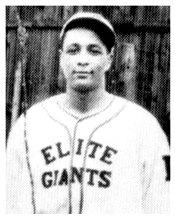

William Byrd
Nicknames: Bill, Daddy, El Maestro
Career: 1932-1950
Positions: p, 1b, of
Teams: Columbus Turfs (1932), Columbus Blue
Birds (1933), Nashville Elite Giants (1933), Cleveland Red Sox (1934), Homestead Grays (1934), Columbus Elite Giants (1935), Washington Elite Giants (1936-1937), Baltimore Elite Giants (1938-1939, 1941-1950), Venezuelan League (1940)
Bats: Both
Throws: Right
Height: 6' 1'' Weight: 210
Born: July 15, 1907, Canton, Georgia
Died: Jan. 4, 1991, Philadelphia, Pennsylvania
One of the last pitchers to have the privilege of throwing a legal "spitter," the Baltimore Elite Giants' ace was a gifted ballplayer, and his presence on the mound was one of unflinching dominance. A workhorse with lots of stamina, he once pitched and won a double‑header with the Elites. In addition to his spitball, he had a wide variety of other pitches and had excellent control of them all. His repertory included a slow knuckler, a fast knuckler, a slider, a roundhouse curve, a fastball, and a sinker. He learned the spitball from Roosevelt Davis while playing with the Columbus Blue Birds in 1933, and would often fake throwing the pitch for psychological reasons.
When Tom Wilson's Elites moved from Nashville to Columbus for the 1935 season, he was recruited to play with the ballclub, an he remained with the franchise as it shifted to Washington and then to Baltimore. A responsible and caring individual as he gained experience, he assumed the role of looking after the welfare of the younger players and became a father figure to some, including Roy Campanella, who called him "Daddy." He remained with the Elites for sixteen years, with the exception of part of one summer season spent in Caracas, Venezuela.
In league games from 1932 to 1949, he maintained better than a .600 winning percentage, suffering only one losing season over a fourteen-year period. In 1936 he is credited with a 20-7 record, and available statistics show league records of 5-3, 6-3, and 9-4 for the years 1937-1939. After a season in Venezuela in 1940, he returned to the Elites and posted a 7-3 record with a 2.75 ERA in 1941, followed with seasons of 10-2, 9-4, 8-7, and 10-6 for the years 1942-1945.
After his first losing season in 14 years, he added three winning seasons in 1947-1949 with records of 9-6, 11-6, and 12-3, the last of these coming in his last year in the Negro Leagues as the Elites won their only untainted pennant.
Byrd was almost a perennial member of the East squad in the East-West All Star game. His five pitching appearances (1936, 1939, 1941, 1944, and 1946) are exceeded only by Leon Day and Hilton Smith. A good hitter, Byrd also made an All Star appearance as a pinch hitter in 1945. He learned to hit by hitting rocks with tree branches on the family farm in Canton, Georgia, and like most pitchers, he took pride in his hitting. He had good power as a hitter and was proud of the four homers he hit while playing in the outfield. He also played on occasion at first base and was often used as a pinch hitter. Regular-season averages include marks of .318 (1936), .286 (1941), .304 (1942), and .344 (1948). But his pitching and hitting were not matched by his baserunning, and the big hurler was slow on the bases.
Throughout his career, he and Leon Day often hooked up in pitching duels in the Negro Leagues, in Venezuela, and in Puerto Rico, where he was called "El Maestro" and led the league in victories during the winter season of 1940-1941, with 15 wins. He also pitched with Santurce in the winter of 1938-1939, and in both Latin American countries, Byrd had Josh Gibson as his catcher.
After beginning the 1950 season with the Elites, Byrd quickly retired, with a lifetime record of 114-72, and contented himself playing semi-pro ball while holding down a regular job at General Electric Company in Philadelphia, where he worked for twenty years before retiring in 1970.
Source: James A. Riley, The Biographical Encyclopedia of the Negro Baseball Leagues, New York: Carroll & Graf Publishers, Inc., 1994.

William Byrd